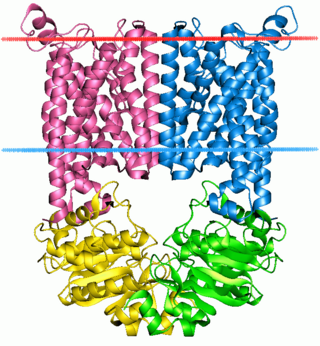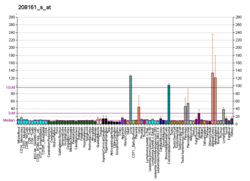
The ATP-binding cassette transporters are a transport system superfamily that is one of the largest and possibly one of the oldest gene families. It is represented in all extant phyla, from prokaryotes to humans. ABC transporters belong to translocases.

P-glycoprotein 1 also known as multidrug resistance protein 1 (MDR1) or ATP-binding cassette sub-family B member 1 (ABCB1) or cluster of differentiation 243 (CD243) is an important protein of the cell membrane that pumps many foreign substances out of cells. More formally, it is an ATP-dependent efflux pump with broad substrate specificity. It exists in animals, fungi, and bacteria, and it likely evolved as a defense mechanism against harmful substances.

Multidrug resistance-associated protein 6 (MRP6) also known as ATP-binding cassette sub-family C member 6 (ABCC6) and multi-specific organic anion transporter E (MOAT-E) is a protein that in humans is encoded by the ABCC6 gene. The protein encoded by the ABCC6 gene is a member of the superfamily of ATP-binding cassette (ABC) transporters.

ATP-binding cassette sub-family C member 4 (ABCC4), also known as the multidrug resistance-associated protein 4 (MRP4) or multi-specific organic anion transporter B (MOAT-B), is a protein that in humans is encoded by the ABCC4 gene.

The ATP-binding cassette 4 gene encodes the Multidrug resistance protein 3. ABCB4 is associated with progressive familial intrahepatic cholestasis type 3 and intrahepatic cholestasis of pregnancy.

ATP-binding cassette super-family G member 2 is a protein that in humans is encoded by the ABCG2 gene. ABCG2 has also been designated as CDw338. ABCG2 is a translocation protein used to actively pump drugs and other compounds against their concentration gradient using the bonding and hydrolysis of ATP as the energy source.

Multidrug resistance-associated protein 1 (MRP1) is a protein that in humans is encoded by the ABCC1 gene.
In enzymology, a xenobiotic-transporting ATPase (EC 3.6.3.44) is an enzyme that catalyzes the chemical reaction

Multidrug resistance-associated protein 2 (MRP2) also called canalicular multispecific organic anion transporter 1 (cMOAT) or ATP-binding cassette sub-family C member 2 (ABCC2) is a protein that in humans is encoded by the ABCC2 gene.

Major vault protein is a protein that in humans is encoded by the MVP gene. 78 copies of the protein assemble into the large compartments called vaults.

Multidrug resistance-associated protein 5 is a protein that in humans is encoded by the ABCC5 gene.

ATP-binding cassette transporter sub-family C member 11, also MRP8 is a membrane transporter that exports certain molecules from inside a cell. It is a protein that in humans is encoded by gene ABCC11.

ATP-binding cassette sub-family B member 9 is a protein that in humans is encoded by the ABCB9 gene.

ATP-binding cassette sub-family D member 2 is a membrane pump/transporter protein that in humans is encoded by the ABCD2 gene.

Multidrug resistance-associated protein 7 is a protein that in humans is encoded by the ABCC10 gene.

ATP-binding cassette sub-family G member 4 is a protein that in humans is encoded by the ABCG4 gene.

Putative ATP-binding cassette transporter sub-family C member 13 is a protein that is not present in humans. In humans, ABCC13 is a pseudogene.

Multidrug resistance-associated protein 9 is a protein that in humans is encoded by the ABCC12 gene.
Michelle Haber is an Australian cancer researcher.
Piet Borst CBE is emeritus professor of clinical biochemistry and molecular biology at the University of Amsterdam (UVA), and until 1999 director of research and chairman of the board of directors of the Netherlands Cancer Institute and the Antoni van Leeuwenhoekziekenhuis (NKI-AVL). He continued to work at the NKI-AVL as a staff member and group leader until 2016.


















